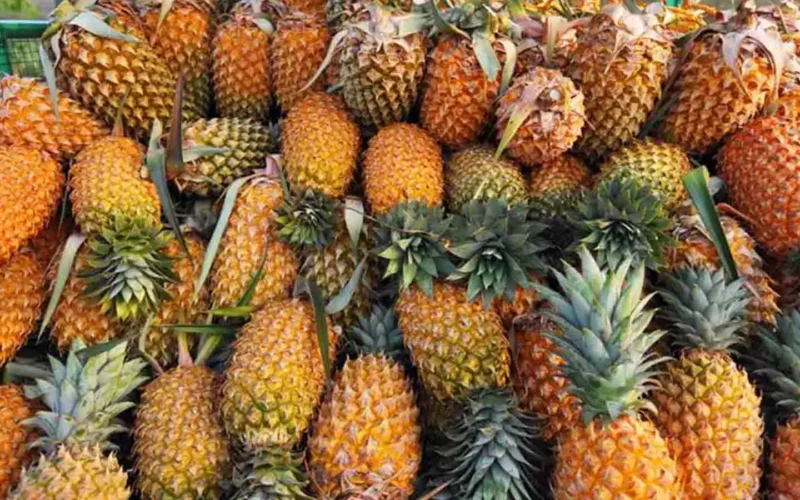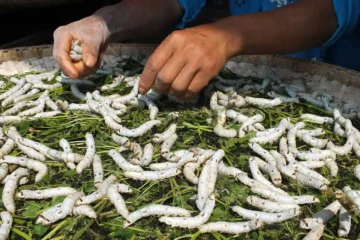Published: April 2017
In our daily diet, fruits play a vital role after greens and vegetables. They enhance our body’s overall health and boost immunity. One such fruit is the pineapple, also known as “poonthalampazham.”
Pineapple, with its rough and spiky outer shell, can be considered a naturally gifted protective armor. It was introduced to India by the Portuguese and became popular along the eastern coastal areas. Grown widely in tropical regions, it is cultivated in gardens, fences, and for commercial purposes. Thus, Siddha literature refers to pineapple as a native plant.
Queen of Tropical Fruits
This fruit, with leaves resembling those of the pandanus, is also called “Parangi thazhai” or “Senthazhai.” Belonging to the Bromeliaceae family, its botanical name is Ananas comosus. Pineapple is most abundantly available during the summer, earning it the title “Queen of Tropical Fruits” in Siddha medicine.
Preservation Challenges
Unlike other fruits that can be preserved, pineapples cannot be stored for long periods due to their tendency to spoil quickly. Therefore, it is best to consume them during their season.
Best Time to Eat Fruits
It is beneficial to consume fruits a few hours before meals rather than with or after meals. Ripe fruits should be chewed well and enjoyed by people of all ages. Pineapple, rich in fiber, aids digestion, alleviates constipation, and cleanses the intestines. It also contains potassium, which helps reduce water retention.
Benefits of Pineapple
Pineapple, with its sweet and tangy taste, is refreshing and cooling. It soothes body heat, promotes urine and sweat production, relieves nasal dryness, and purifies the blood. The low sugar and fat content in pineapple juice makes it effective in reducing obesity.
Consuming 200 ml of pineapple juice mixed with 50 ml of ginger juice, 10 grams of carom seeds, and the necessary amount of sugar, heated and cooled, can alleviate indigestion, gastritis, and stomach ulcers. This mixture should be consumed in doses of 60 to 100 ml three times a day.
For Children
Mixing two teaspoons of pineapple juice with honey can help treat indigestion, gastritis, intestinal worms, and diarrhea in children, promoting healthy growth.
For Hiccups
A mixture of 300 ml pineapple juice, 200 grams sugar, and 20 grams roasted and powdered cumin can be boiled until it thickens and then cooled. Consuming 50 ml of this mixture every three hours can stop hiccups and relieve heartburn. For children, a teaspoon of this mixture with a pinch of roasted asafoetida can treat hiccups, indigestion, and respiratory issues.
Pineapple Tablets
A mixture of 200 ml pineapple leaf juice, 300 ml pineapple juice, 150 grams of powdered Trikatu (a mixture of black pepper, long pepper, and ginger), and 100 grams of Triphala (a combination of three fruits) can be ground into tablets the size of Indian gooseberries and dried in the shade. Taking two of these tablets with cool water thrice daily for 60 days can act as a preventive medicine for elephantiasis and leprosy caused by mosquito bites.
Pineapple Sherbet
Boil 800 ml pineapple juice with 10 grams of Nannari root powder, 10 grams of liquorice, and the required amount of sugar until it thickens. Mixing 30 ml of this concentrate with 200 ml of water and drinking it can alleviate urinary irritation, body odor, and body heat, refreshing both body and mind.
For Women
Boil 800 ml pineapple juice, 20 grams of sesame seeds, 20 grams of washed aloe vera pulp, 10 grams of black cumin, 10 grams of asafoetida, 20 ml onion juice, 20 ml garlic juice, 10 grams each of dry ginger, black pepper, and long pepper powder, and the required amount of sugar until it thickens. Consuming 30 ml of this mixture thrice daily for three days can relieve menstrual pain and regulate blood flow.
Special Notes
It is advisable to avoid eating pineapples during the rainy and cold seasons. People with ulcers or pregnant women should avoid consuming pineapples. Contrary to popular belief, pineapples do not cause excessive heat, stomach pain, or diarrhea. The heat content in pineapples is 14 calories, the same as in other fruits, while the acidity level of tamarind, which we use daily, is 82 calories.
Applying fresh pineapple juice externally can cure the initial stages of leprosy, according to Siddha practitioners.
Dr. P. Kumaraswamy, Former Government Siddha Doctor, Chengalpattu.











